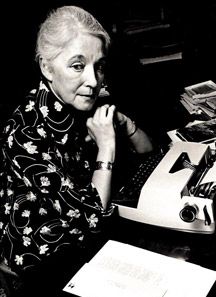 Elizabeth Searle Lamb
Elizabeth Searle Lamb
(22 January 1917 – 16 February 2005)
ON READING HAIKU
Whatever it takes
to write
haiku
it takes almost
as much of
to read
hearing sound
on the page
and seeing shape
in the ear
but then mostly
just the courage
to let old Basho’s frog
Jump
(Haiku West 7:2, January 1974)
Elizabeth Searle Lamb was rightfully named the "First Lady of American Haiku" by the prominent poet Father Raymond Roseliep. In 1968 she was among the first people to join the Haiku Society of America and served as an editor to its journal Frogpond for many years.
Elizabeth Lamb was born in Topeka, Kansas on 22 January 1917. She came from a musical family and studied and played harp during her high school years. She graduated from college with a B.A. in literature in 1938 and a Bachelor’s of Music in 1939. When Elizabeth graduated from the University of Kansas she was the first to be awarded a degree in harp from the Music School.
In college Elizabeth Searle played music with a fellow student, a flautist named Bruce Lamb. Soon they began dating and fell in love. They got married in December 1941, and she moved with him to Trinidad, West Indies for two years. Bruce Lamb’s work as a tropical forester meant that the family lived in South and Central America for many years, and Elizabeth could not pursue her musical career. Therefore, she began to write and publish children’s stories, short stories, and spiritual poetry.
In 1961, Lamb and her husband moved to New York. This is where she was first introduced to the art of haiku. She began to study, read, and write about this form of poetry and in 1968 she became a member of the Haiku Society of America (HSA). In 1971, only ten years after she learned of haiku, she became the President of the HSA. Since this time, she has had her work published in many haiku magazines and newspapers. Her work was translated into Japanese, Chinese, Polish, French, Spanish, etc. She has participated in many festivals and held various offices incl. Elizabeth was involved in the establishment of the American Haiku Archives (AHA). She donated her library and papers that became the core of the archives, and was the first Honorary Curator of the AHA (1996–1998).
Elizabeth Searle Lamb passed away 16 February 2005 in Santa Fe, New Mexico.
Some Awards:
Elizabeth Lamb has won more than 150 awards in the haiku field among them:
- Harold Henderson Awards (1978, 1981)
- Haiku Society of America Biennial Book Awards (1979, 1983, 1985/86)
- Mainichi Daily News best of issue (1988)
Published books:
- In this blaze of sun (From Here Press, 1975);
- Picasso’s "Bust of Sylvette": haiku and photographs (Garlinghouse Printers, 1977);
- 39 blossoms (High/Coo Press, 1982);
- Casting into a cloud: southwest haiku (From Here Press, 1985);
- Lines for my mother, dying (Wind Chimes Press, 1988);
- 美国俳句100首 / 美国俳句100首 The Light of Elizabeth Lamb: 100 American Haiku, Translated into Chinese by Haiping Gong, 1993;
- Ripples spreading out: poems for Bruce and others (Tiny Press Poems, 1997);
- Platek irysa (Miniatura, 1998);
- Across the windharp: collected & new haiku (La Alameda Press, 1999).
Selected work:
Picasso’s ‘Bust of Sylvette’
not knowing it is a new year
smiles in the same old way
(Picasso’s Bust of Sylvette, E. Lamb, 1977)
*
cry of the peacock the crack in the adobe wall
(Harold G. Henderson Awards 1981, 2nd; Frogpond 4:3, 1981)
*
the apricot
in full bloom — O’Keeffe’s
black sculpture
(https://www.thehaikufoundation.org/omeka/files/original/2d114d32f6ae56ba1450fd0faa189b8a.pdf)
*
beneath the portal
a summer tourist buys turquoise
to match the sky
(Nexus 24:2, winter 1989)
*
Six Haiku for The Acequia:
before firstlight
the wild plum blossoms
whiten the dry ditch
from the dead tree
a santero carves St. Francis
there on the ditch bank
Ditch-Cleaning Day
the mayordomo’s pickup
has a flat
half silted under
the dead puppy
after spring run-off
a white horse
drinks from the acequia
blossoming locust
ancient cottonwoods
drop their leaves in the acequia
September’s brittle wind
(Archive of New Mexico Poetry website))
*
the blind sculptor
his own features
on all the bronzes
shiverrrring
on the winter balcony
first star
wind in the sagebrush—
the same dusty color
the smell of it
his voice
reading his poems
still
(Lamb, Across the Windharp, 1999)
*
flight of the cranes
surely just dream but
this white feather
(55th Annual Basho Festival, 2001)
*
pausing
halfway up the stair-
white chrysanthemums
(Haiku Mind: 108 Poems to Cultivate Awareness and Open Your Heart, ed. by Patricia Donegan, 2014)
Most information for this profile has been kindly provided by Charles Trumbull. Charlie, we are very grateful for all your help and dedication!
Sources:
- http://www.americanhaikuarchives.org/curators/ElizabethSearleLamb.html
- http://performance.millikin.edu/haiku/writerprofiles/lamb.html
- https://terebess.hu/english/usa/lamb.html
- https://bashosroad.outlawpoetry.com/elizabeth-searle-lamb-the-wasp/elizabeth-searle-lamb/haiku/
- http://www.lorenwebster.net/In_a_Dark_Time/2011/07/19/patricia-donegans-haiku-mind/
- https://bearcreekhaiku.blogspot.co.uk/2016/02/elizabeth-searle-lamb-and-mariam-sagan.html
Some essays on Elizabeth Lamb:
- http://www.hsa-haiku.org/frogpond/2011-issue34-2/essay.html
- http://performance.millikin.edu/haiku/writerprofiles/KussartOnLamb.html
- Charles Trumbull, “Elizabeth Searle Lamb—New Mexico Haiku Poet,” Malpaís Review (Gary L. Brower, ed., Placitas, N.M.), winter 2012–13, 118–33; archived at http://www.thehaikufoundation.org/omeka/items/show/1154
